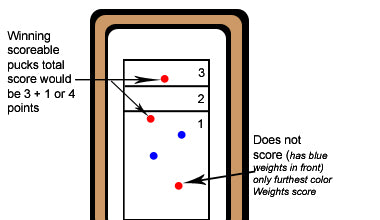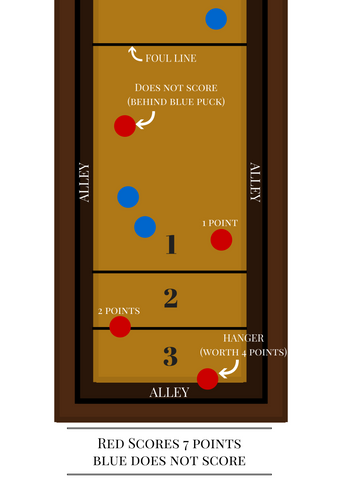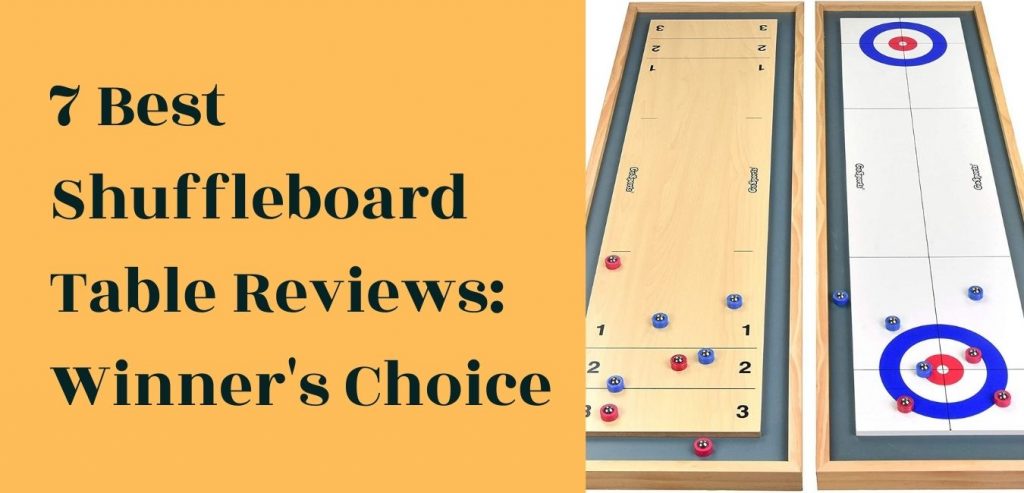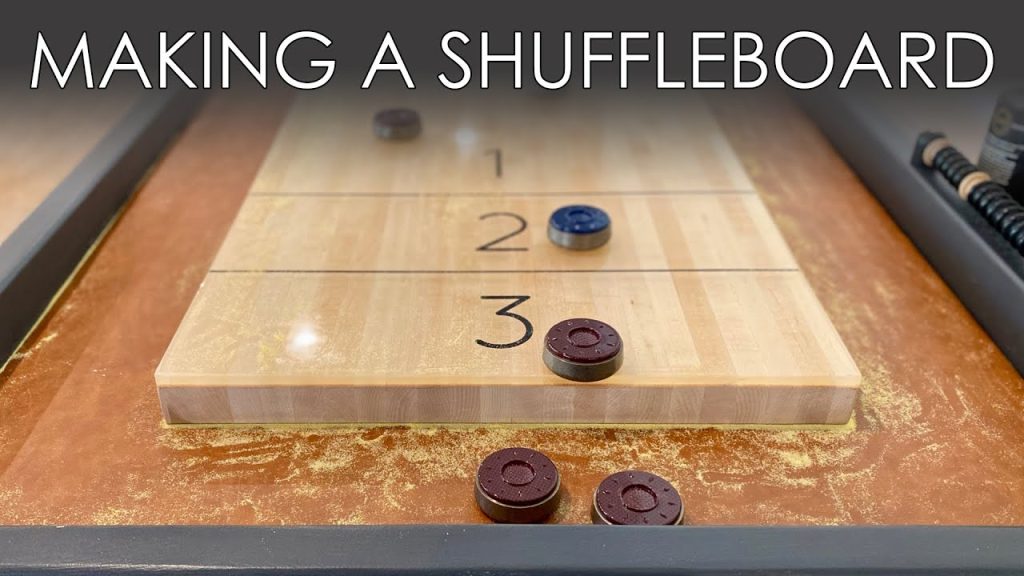Shuffleboard is a fun and competitive game. It is easy to learn and enjoy.
Shuffleboard has been a popular game for centuries. It involves sliding pucks down a long, smooth surface to score points. The aim is to land your pucks in the highest scoring area. You can play it indoors or outdoors, with friends or family.
This game is great for all ages and skill levels. It combines strategy, skill, and a bit of luck. Learning how to play shuffleboard can be a rewarding experience. It offers a fun way to spend time and improve your hand-eye coordination. Ready to dive into the world of shuffleboard? Let’s get started!
Introduction To Shuffleboard
Shuffleboard is a fun and engaging game that can be played by people of all ages. Whether you’re a beginner or have some experience, learning the basics can help you enjoy the game even more. This guide will introduce you to the game of shuffleboard, covering its history, popularity, and variations.
History And Origins
The game of shuffleboard has a rich history. It dates back to the 15th century in England. Initially, it was played by sliding coins on a table. Over time, the game evolved. It became popular among the English nobility. By the 19th century, shuffleboard had made its way to America. It was played on ships to pass the time during long voyages. This maritime tradition helped spread the game even further.
Popularity And Variations
Shuffleboard has gained popularity in many parts of the world. It’s played in pubs, homes, and even at professional tournaments. There are several variations of the game. Each variation offers a unique twist. Here are a few popular ones:
- Table Shuffleboard: Played on a long, narrow table. Players slide pucks towards the opposite end.
- Deck Shuffleboard: Common on cruise ships. Played on a marked floor with long cues.
- Outdoor Shuffleboard: Played on a court. Pucks are slid towards a scoring triangle.
Each variation has its own set of rules and equipment. Understanding these differences can enhance your enjoyment of the game.
Essential Equipment
Shuffleboard is an exciting game that requires specific equipment. This section will detail the essential items you need to play shuffleboard. Understanding the equipment will help you enjoy the game better and improve your skills.
Shuffleboard Table
The shuffleboard table is the most critical piece of equipment. These tables come in various lengths, typically ranging from 9 to 22 feet. A longer table provides a more challenging game. The surface of the table is smooth and polished, allowing the pucks to glide effortlessly. It often has a coat of silicone spray to reduce friction. Additionally, the table has gutters on both sides to catch stray pucks.
Pucks And Weights
Pucks or weights are small, round discs used to score points. Each player uses a set of four pucks, marked by different colors. The pucks are designed to slide smoothly across the table’s surface. They are typically made of durable materials like stainless steel. Proper care of pucks ensures a consistent game experience.
Scoring System
The scoring system in shuffleboard is simple yet strategic. The table is marked with different zones, each representing a specific point value. Points range from 1 to 3, with 3 being the farthest from the starting point. The goal is to slide your pucks into these zones while knocking the opponent’s pucks off the table. A game is usually played to 15 or 21 points, and the player with the highest score wins.
| Equipment | Description |
|---|---|
| Shuffleboard Table | Smooth, polished surface ranging from 9 to 22 feet. |
| Pucks and Weights | Small, round discs made of durable materials. |
| Scoring System | Zones marked on the table representing different points. |
Basic Rules Of Play
Learning how to play shuffleboard is fun and easy. The game requires strategy and skill. Before you start playing, you must understand the basic rules. This will help ensure a fair and enjoyable game for everyone.
Setting Up The Game
First, you need a shuffleboard table. Make sure it is clean and level. You will also need eight pucks, four for each player. Pucks usually come in two colors. Place the pucks at the end of the table. Each player stands at the same end of the table to start.
Gameplay Mechanics
Players take turns sliding pucks down the table. The goal is to get your puck as far as possible without it falling off. You can also knock your opponent’s puck off the table. The player whose puck is closest to the edge scores points. Only the puck closest to the edge counts for scoring.
Winning The Game
The game continues until a player reaches a set number of points. Usually, this is 15 or 21 points. Keep track of points each round. The first player to reach the target score wins. If no player reaches the target score, the game continues.

Credit: www.youtube.com
Key Techniques
Learning how to play shuffleboard can be both fun and rewarding. It combines strategy and skill. Let’s dive into the key techniques that will help you excel at this engaging game.
Proper Stance And Grip
Start with a balanced stance. Keep your feet shoulder-width apart. Bend your knees slightly. This gives you stability. Hold the cue stick with a relaxed grip. Your dominant hand should be in control. The other hand provides support. This helps you guide the puck smoothly.
Shooting Techniques
Push the puck gently with the cue. Avoid hitting it too hard. Aim for a steady, consistent motion. Focus on your target zone. Keep your wrist straight. This ensures accuracy. Practice different shots. Try to understand how the puck moves.
Controlling Speed And Direction
Control the speed of the puck by adjusting your push. A light push makes the puck move slowly. A stronger push makes it go faster. Learn to judge the distance. Aim for the right spot. Practice directing the puck where you want it to go. This takes time and patience.
Remember, practice makes perfect. By mastering these key techniques, you can improve your shuffleboard skills and have more fun playing the game.
Advanced Strategies
Shuffleboard is more than just sliding pucks on a board. Advanced strategies can give you an edge over your opponents. Understanding and employing these tactics can make you a formidable player. This section focuses on advanced strategies that will elevate your game.
Offensive Tactics
Offensive tactics are essential to score points and win games. Here are some strategies:
- Zone Control: Aim to place your pucks in high-scoring zones while blocking your opponent.
- Bumping: Use your puck to bump your opponent’s puck out of scoring zones.
- Speed Variation: Alter the speed of your shots to keep your opponent guessing.
Defensive Tactics
Defense is equally important in shuffleboard. Effective defensive strategies can prevent your opponent from scoring. Consider these tactics:
- Guarding: Place your pucks in front of your high-scoring pucks to protect them.
- Blocking: Position your pucks to block your opponent’s path to high-scoring zones.
- Clearing: Use your puck to knock your opponent’s pucks off the board.
Reading The Opponent
Understanding your opponent’s strategy can give you a significant advantage. Pay attention to:
- Patterns: Notice if they have a consistent playing style or favorite zones.
- Weaknesses: Identify areas where they consistently miss or lack control.
- Reactions: Observe how they respond to your offensive and defensive moves.
By combining these advanced strategies, you can improve your shuffleboard skills and outplay your opponents. Practice regularly to master these techniques and become a top player.
Common Mistakes
Playing shuffleboard is an exciting and strategic game. Yet, beginners often make common mistakes. Recognizing these errors can help improve your game significantly.
Incorrect Shooting Form
Many players struggle with their shooting form. They often grip the puck too tightly. This restricts fluid movement and control. Keep your wrist relaxed. Use a smooth, consistent motion. This helps in achieving better accuracy and power.
Misjudging Weight And Speed
Weight and speed are crucial in shuffleboard. New players often misjudge them. They either push too hard or too soft. Practice adjusting your strength. Observe how far the puck travels. This improves your feel for the table and game.
Poor Table Maintenance
A well-maintained table is key. Dirty or uneven surfaces affect puck movement. Regularly clean the table. Apply shuffleboard wax or silicone spray. This ensures a smooth playing field. Proper maintenance keeps the game fair and enjoyable.
Shuffleboard Etiquette
Playing shuffleboard is an enjoyable and competitive activity. To ensure the game remains fun for everyone, it is important to follow proper shuffleboard etiquette. This includes respecting your opponents, taking care of the table, and ensuring fair play. Let’s dive into the details.
Respecting Opponents
Respect your opponents to keep the game friendly. Sportsmanship is key.
- Shake hands before and after the game.
- Avoid trash talk.
- Applaud good shots, even from your opponent.
Keep your cool. Losing your temper can spoil the fun for everyone.
Table Care And Maintenance
Proper table care ensures a smooth game. It also extends the life of the shuffleboard table.
- Wipe the table clean before and after each game.
- Use shuffleboard wax to maintain a slick surface.
- Check for damages regularly. Report any issues.
Always use the correct equipment. This prevents damage and keeps the table in top condition.
Fair Play
Fair play is the foundation of any good game. Shuffleboard is no exception.
- Follow the rules of the game.
- Do not cheat or bend the rules.
- Respect the decisions of the scorekeeper.
Fair play keeps the game honest and enjoyable. It builds trust and respect among players.

Credit: mccluretables.com
Practicing And Improving
Practicing and improving in shuffleboard can take your game to the next level. Whether playing alone or with others, consistent practice helps you refine your skills. Here are some practical ways to practice and improve.
Solo Practice Drills
Practicing alone allows you to focus on your weaknesses. Set up targets on the board. Aim to hit these targets with each shot. This helps improve your aim and control. Another drill is to practice sliding pucks to different distances. This enhances your ability to judge force and direction.
Playing With Partners
Playing with others adds an element of competition. It also helps you understand different playing styles. Partner practice can involve friendly matches. Alternatively, work together on specific drills. For instance, you can take turns aiming at targets. This makes practice sessions more dynamic and fun.
Joining Shuffleboard Leagues
Joining a league can greatly improve your skills. Leagues offer regular practice and competitive play. They also provide a community of fellow players. Being part of a league lets you learn from more experienced players. It also keeps you motivated to practice regularly.
Shuffleboard For All Ages
Shuffleboard is a game that everyone can enjoy. It doesn’t matter how old you are. This game can be played by kids, adults, and seniors. It offers a mix of fun, competition, and health benefits.
Family Fun
Playing shuffleboard with your family is a great way to bond. It allows everyone to participate. The rules are simple, making it easy for kids to learn. Adults can help children understand the game. This makes it a fun activity for family gatherings.
Here are some ways to make it more enjoyable:
- Create teams with mixed ages.
- Set up mini-tournaments.
- Give small prizes for winners.
Competitive Play
Shuffleboard can also be a competitive sport. Many people enjoy playing in leagues and tournaments. This adds a level of excitement. Playing competitively helps improve skills. It also offers a chance to meet new people. Here are some tips for competitive play:
- Practice regularly to improve accuracy.
- Learn advanced strategies.
- Stay focused during the game.
Health Benefits
Playing shuffleboard has several health benefits. It is a low-impact activity. This makes it suitable for all ages. Here are some health benefits:
| Benefit | Description |
|---|---|
| Physical Exercise | It involves walking and bending, which helps keep you active. |
| Improves Hand-Eye Coordination | Aiming and shooting the pucks enhances coordination. |
| Mental Stimulation | Strategies and planning keep the mind sharp. |
Whether for fun, competition, or health, shuffleboard is a great choice. It’s a game that brings people together and keeps them active.

Credit: www.youtube.com
Frequently Asked Questions
What Is Shuffleboard?
Shuffleboard is a game where players use cues to slide weighted pucks down a narrow, smooth table into a scoring area.
How Do You Score In Shuffleboard?
Points are scored by sliding pucks into marked zones at the table’s end. Zones have different point values.
What Equipment Is Needed For Shuffleboard?
You’ll need a shuffleboard table, pucks (weights), and cues to play the game.
How Long Is A Shuffleboard Table?
Shuffleboard tables typically range from 9 to 22 feet in length.
Conclusion
Shuffleboard is a fun and engaging game for all ages. Follow the basic rules and practice regularly. Enjoy playing with friends and family. Remember, patience and precision are key. Whether at home or on vacation, shuffleboard offers endless entertainment. Now, gather your pucks and cues.
Get ready to enjoy this classic game. Happy playing!



